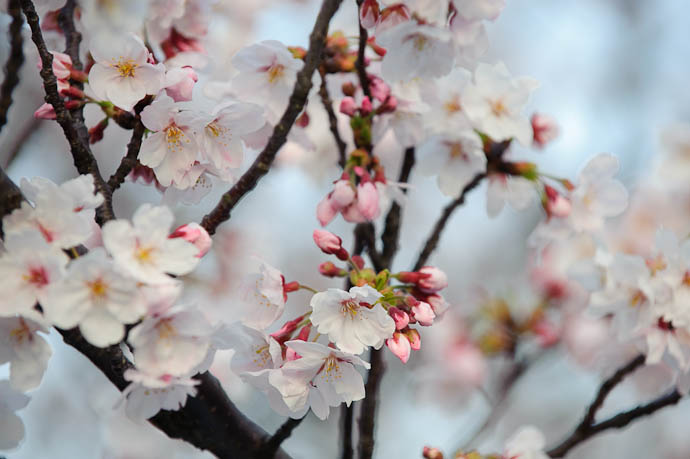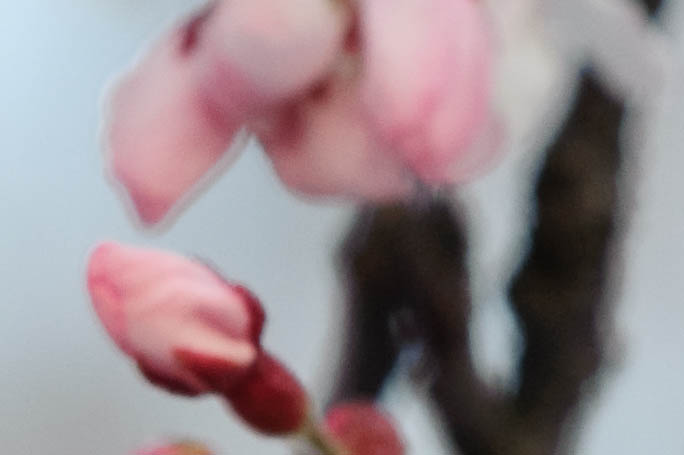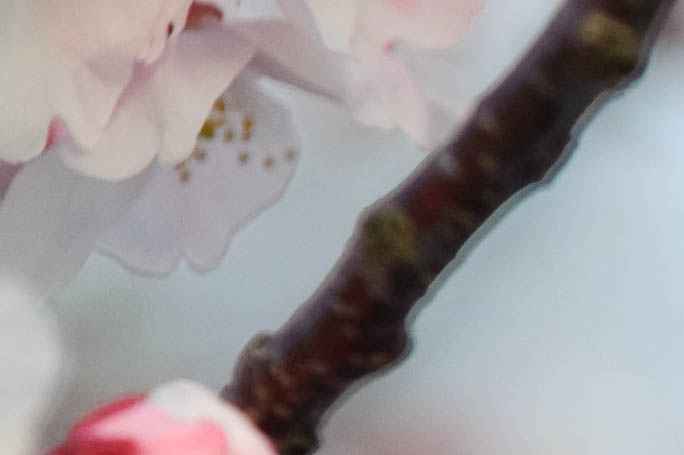
Nikon D700 + Nikkor 70-200mm f/2.8 @ 200 mm — 1/400 sec, f/6.3, ISO 900 — map & image data — nearby photos
sorta' pretty, but
Something Strange
The photo above is a repeat of the first photo in yesterday's post. They're some cherry blossoms that were overhanging our car in the parking lot of a restaurant on Awaji Island. The image has some strange artifacts that I'm at a loss to explain, so thought I'd ask whether anyone understands their source.
Here are two full-resolution crops – one from near the center, and another from left of center – that show some odd haloes around some items, but not around others...
Clicking on any of these images brings up the full-resoltion 4,256 × 2,832 pixel image.
These kind of effects are often the result of heavy-handed post processing.... adding too much fill light, or tweaking the luminosity or saturation of the background, for example, but none of that went on here. The image and crops here are just as loaded in Lightroom without any post-processing whatsoever.
(Actually, while wondering whether the effects were influenced by the camera-calibration setting, I tried several. None seemed to have any impact the strange effect, but I preferred the “Camera Vivid” calibration for this one, so did leave it at that setting for these examples.)
I also checked the full-resolution jpeg embedded within the raw file, as well as a simple conversion of the raw data with dcraw, and found no differences, so it's certain that the effects were created in camera.
Camera shake could cause artifacts like this, but in that case I would expect the odd effect to be uniform across the image. Subject shake could account for localized effects, but in the branch crop, for example, it's much more pronounced on one side of the branch than the other, which rules out that the branch was shaking really really fast (the shutter speed is 1/400th of a second).
I also wondered for a bit whether it might be some kind of hiccup with the lens' VR mechanism, but like camera shake, I'd think that would affect all areas of the frame equally.
I'm at a total loss to explain this, and find myself at the point of wondering whether there's such a thing as translucent bark. Any ideas?


Might be VR, which AFAIK vibrates the edges more.. Alternatively, how windy was it?
Couple fo effects here due to the lens not the sensor or processing. Check out this link and pan down to the section on spherical abberation for a run-down.
That is weird! It appears to be strongest on high contrast edges that are slightly out of focus. It also appears to be in a vectored direction from top left to bottom right. I wonder if the in-camera processing tries to enhance edges to make them pop and is then getting confused with these slightly out-of-focus edges. If that’s the case, you should be able to reproduce this fairly easily. After successfully reproducing, you could also compare the D700 with your old D200 (if you still have it) to see if there’s a difference. At some point, I might try to reproduce with my D300, of course, that requries time to actually devote to my camera. 😉
So, there are a bunch of what-ifs and could-bes for you. I hope it helps. 🙂
-MSD
It does look a little odd. My first thought was subject movement, but the uniformity of the effect around the bud in the first crop, coupled with a 1/400th shutter speed, makes that seem unlikely. It appears on vertical and horizontal objects uniformly (witness the mostly-horizontal branches in the lower right, and the mostly-vertical branches in the lower middle).
Do you have multiple shots of the same subject, and if so does it change shot-to-shot? That would point to VR. Any shots with other lenses? Can you recreate it?
An interesting problem.
You wrote: “Subject shake could account for localized effects, but in the branch crop, for example, it’s much more pronounced on one side of the branch than the other, which rules out that the branch was shaking really really fast (the shutter speed is 1/400th of a second).”
I think that branch motion toward and away from you at a slight diagonal could result in the blur on only one side. In this case, I agree, the shutter speed seems too short for any blur.
However, I made a ‘back of the envelope’ calculation of the lateral velocity necessary to produce the blur on the twig. If the twig is 0.25 inches in diameter and the blur is 1/10 of that or 0.025 inches, then to move 0.025 inches in 1/400 of a second is a velocity of only 10 inches per second, or about 0.6 miles per hour. Much slower than I would have guessed. So maybe motion of the subject is still a possibility?
Jack in California
My guess: since the effect is in the out of focus areas, I’d call it “beginning bokeh”.
Hmm, i.m.o. is due to the shaky branches + the bokeh that cause the holo around the the brances and the leaves. Or perhaps is due to front and back shaking rather than left right.
Hahaha… that the reason i can think of.
I’m not sure I would dismiss subject motion quite so readily. It seems like the most likely option to me.
Ben
Oxford, Mississippi, USA
Halos are around a bud, and a small branch, both of which are heavier compared to the cherry blossoms that area ll around them. Since heavier objects carry more momentum compared to lighter ones, any breeze that triggered an oscillation in the heavier bud could have taken a longer time to damp down, compared to the cherry blossoms. The frequency oscillation also has something to do with the length, the shorter, the faster. Shutter speed of 400 is around 25 milli-seconds.. For example a 5KMpH breeze moves at ~3.5 mm in 25 mill seconds. That may be a lot of movement for the high end camera to miss 🙂
It’s not your camera – it’s a ripple in the space-time continuum centered on that specific cherry tree . Maybe it’s a porthole to another universe. As further proof of this explanation – some of hairstyles on the young adults in your “coming of age day” post couldn’t have been of this world!
Something that crossed my mind while looking at this photo is aberration? The Bokeh in this photo doesn’t seem very smooth in the background and aberration may have something to do with that. I know the Nikkor 70-200mm f/2.8 is an ED lens and reduces chromatic aberration, but maybe you found the setting that it can’t compensate for. Just a thought.
I would guess motion blur, accentuated (widened) by the way that the affected areas are out of focus.
We photograph dancers in studio with high speed flashes, and during their jumps we get blurry feet if we miss the ‘peak’, even at the equivalent of 1/5000 sec. Things just need to move a little to become mighty blurry.
Mirror slap is known to cause blurriness, and if you think about it that s a very small amount of motion of the camera. Compare that to a gust of wind shaking the plant, and at high magnification even 1/400 isn’t enough to freeze that motion.
My best guess is simple subject motion. You see it more on one side of the branch then the other because its dark on a light background rather then the lightening on the other side which just looks like defocus. Heck it could just be camera motion. Even at 1/400 of a second at higher resolution its ever so easy to see eve the smallest camera and object movements. easy way to test it though, if you have an overhead fan, photograph the moving blades (assuming dark blades, backlit) slightly defocused, preferably with a low dof , see if this effect shows up.
It’s not motion blur. Motion blur gives a distinctive streaking effect, sort of like comet tails. The streaks would be uni-directional. Subjects would appear out of focus. Different types of motion give different, distinctive streaking patterns. If this was wind motion, you’d see a more random effect across the frame. Plus, wind motion is almost impossible to catch faster than 1/125s.
As I pointed out with my earlier link, it’s spherical aberration (or more correctly, poorly corrected SA). You can tell in the way there is uniform effect around objects and the progressive nature as subjects get further from the focal plane.
I would be inclined to think the halos are a side effect the lens produces on the out of focus images. It seems that the parts of the photo nearer the focal plane suffer less from this halo effect.
As an interesting sidenote, you might be interested at taking a look at this site,
http://www.naturfotograf.com/AFS70-200VR_rev04.html
which discusses the effects of VR on the bokeh of the 70-200.
Daniel.
My guess? The VR mechanism AFAIK only moves one element of the lens to compensate for shake, so you could be seeing a ghosted image from one of the elements that do not move. And the reason why some of the image has this effect and the rest dosen’t could be accounted to paralax, i.e. the sensor plane was moving on the horizontal or vertical axis… Just my humble, non-professional opinion.
I’ve seen this in some of my images as well, especially outdoors. Not sure why.
check out this post by Thom Hogan and what he calls “bounce back flare”
http://forums.dpreview.com/forums/readflat.asp?forum=1030&message=31660493
It looks like corrected chromatic aberration to me. But as for it pre-existing on the embedded JPG, I’m at a loss, unless the camera somehow applies that fix that on the fly?
I suspect VR.
I have a Sigma VR lens that produces the exact same issue. It seems to happen only when you’re at the very edge of what the VR can compensate for.